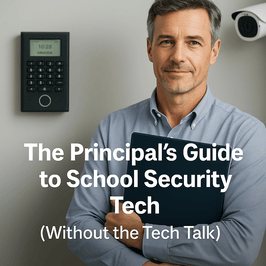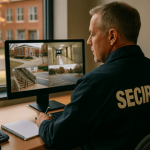
Running a school means wearing a lot of hats. You are an educator, manager, community leader, and sometimes even a crisis coordinator. With so many responsibilities, it's easy to feel overwhelmed by the growing number of security technologies being introduced into schools today.
The reality is you should not need a background in technology to make smart, effective decisions about campus safety. What you do need is a clear understanding of the most important tools that can help protect your students, staff, and buildings.
This guide is written for school leaders who want to be informed without the confusion. We will walk through the essentials of school safety technology using simple, straightforward language. No technical jargon. Just real solutions that help you create a safer and more secure environment for your school.
k
k
Access Control: The New Front Door
You would not leave your house unlocked during the day. Schools should not either. That is where access control systems come in.
These systems let you decide who gets in, when, and where. Instead of handing out physical keys, staff use fobs, badges, or even mobile credentials. You can schedule when doors lock, grant temporary access to vendors, and lock down your campus remotely in an emergency.
Most importantly, cloud based access control gives you a digital record of every entry, which helps during investigations or drills.
Key takeaway: You do not need every door to be high tech. Focus on main entrances and critical areas like front offices or admin wings.
k
k
Emergency Alerts: More Than Just the PA System
Intercoms and fire alarms are only part of the equation. Today’s emergency alert systems are designed to reach the right people in real time with silent panic buttons, mobile alerts, and even automated lockdowns.
These systems are especially important for Alyssa’s Law compliance in states that require panic alert capabilities in schools.
Staff can send an alert from their badge, phone, or desktop. The system instantly notifies administrators, law enforcement, and anyone else in your response plan.
Key takeaway: These tools save critical time during emergencies and are easy for staff to use.
k
k
Surveillance: Smart Cameras, Not Big Brother
Not all camera systems are created equal. The best ones give you visibility where it counts such as entrances, parking lots, hallways, and common areas.
Modern cloud based video systems let you view footage from any device, store recordings securely offsite, and share clips instantly with first responders if needed.
Some even include smart features like motion detection or license plate recognition so you can skip hours of footage review.
Key takeaway: Surveillance helps with investigations, accountability, and deterrence. Keep your focus on visibility, not over surveillance.
k
k
Visitor Management: More Than Just a Sign In Sheet
A clipboard in the front office does not cut it anymore. Digital visitor management systems help schools track who is on campus at all times and why they are there.
Guests scan their ID, take a quick photo, and get a printed badge. The system checks visitor names against watchlists and notifies staff when someone arrives.
Key takeaway: It is about keeping unapproved visitors out while helping approved ones feel welcome and safe.
kk
k
Integration: When Systems Work Together
This is where things get powerful. When access control, alerts, and video systems are connected, you get a cohesive emergency response.
For example:
- A panic button is pressed
- Doors lock automatically
- Cameras begin recording
- Notifications are sent in real time
This type of integrated security turns isolated tools into a safety network that supports your team, even if you are off site.
Key takeaway: Integration saves time, reduces confusion, and improves outcomes during a crisis.
k
k
Final Thoughts: You Do Not Need to Be a Tech Expert
As a school leader, your role is not to program cameras or run network cables. It is to create a safe, supportive environment for your students and staff. When you understand the basic functions of your school security systems, you are better equipped to make informed decisions, justify funding requests, and support your team.
At SSP, we help school leaders implement security solutions that match their team, their buildings, and their budget. We will walk you through the options in plain language, take care of the details, and make sure you are always prepared.
Let us talk. We will help you simplify your school’s security strategy and make it work for your campus.


